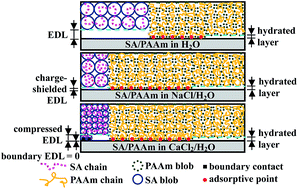Low-velocity super-lubrication of sodium-alginate/polyacrylamide ionic–covalent hybrid double-network hydrogels
Abstract
Structural and frictional behaviours of sodium alginate (SA)/polyacrylamide (PAAm) ionic–covalent hybrid, sequential double-network (DN) hydrogels against glass have been investigated in water, NaCl and CaCl2 aqueous solutions using a rotational rheometer. Dilution of adsorptive elastohydrodynamic friction for the PAAm covalent network with repulsive hydrodynamic lubrication for the minor SA ionic network was found to control the frictional stresses of the SA/PAAm gels within between those of the SA and PAAm single-network gels. A tentative qualitative model was proposed to describe the impact of ionic environmental solution on the frictional behaviour of the hybrid gel by selectively affecting the SA-network structure and friction. It was revealed that strong Debye shielding in the NaCl solution significantly reduced the thickness of the electric double layer for hydrodynamic lubrication of the SA network, which made the SA/PAAm gel's friction the highest among the three solutions. Dramatically increased ionic cross-linking of the SA network in the CaCl2 solution, although effectively mediated by the PAAm-network flexible skeleton, still functioned partially to conserve a portion of the SA fractional boundary-friction at the interface, making the friction of the hybrid gel intermediate among the three solutions. In contrast, extreme hydration of the SA network in water sharply increased the volume fraction of its unshielded hydrodynamic lubrication at the interface, which greatly reduced the SA/PAAm's friction to the lowest among the three solutions. We have thus incorporated for the first time both super-lubrication (frictional coefficients of below 10−2 over low sliding-velocities of 3 × 10−5 to 2 × 10−3 m s−1) and previously reported high fracture energy (over 9000 J m−2) into a single ionic–covalent hybrid DN hydrogel, which is the SA/PAAm (∼1/8.5 w/w) gel in water. Effects of inversion of DN-formation sequence further indicated that frictional behaviours (i.e. frictional stress–sliding velocity profiles) of the hybrid sequential DN hydrogels (SA/PAAm and PAAm/SA), respectively, were primarily determined by those of the second networks (PAAm and SA), presumably due to the formation of first–second network “core–shell” structures at the blob scale. Frictional stress of the SA/PAAm gel was increased monotonically with external normal pressure at all of the sliding velocities investigated in the three solutions, which was in agreement with the predictions from the repulsion–adsorption model proposed by Gong et al.


 Please wait while we load your content...
Please wait while we load your content...